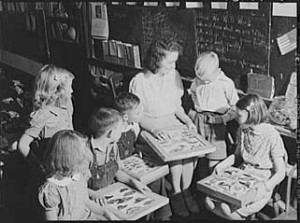Teaching American History Programs Update
March 30, 2011
This summer middle-school and high school teachers from Queens, Brooklyn, and Staten Island participating in ASHP/CML’s Teaching American History professional development program attended two four-day Summer Institutes. The workshops provided an opportunity for teachers from Regions 4 and 7 in the New York City public school system to use the historical information and approaches they had learned during the previous year to create classroom activities for the 2005-06 school year. Participants, led by historians and history educators, worked with sets of 10 to 15 documents, including photographs, cartoons, letters, and oral histories and then met in groups to create activities using the primary sources, such as devising document based questions, role playing situations, and debates. Teachers had an opportunity to model many of their activities in front of peers and to receive constructive feedback.
n
The Summer Institute also featured several guest presenters. For example, Eugene Resnick, a social studies teacher from Midwood High School in Brooklyn presented “Doing Local History,” about assignments he developed to teach major themes in U.S. history through students exploring their own neighborhoods. Terry Judson, Sara Wolf, and Michael Starkey from International High School in Queens conducted a workshop on adapting primary source materials for English as a Second Language and low-literacy learners.
n
Critical interrogation of documents was a key component of ASHP/CML’s Teaching American History 2005 Summer Institute (which is funded by the U.S. Department of Education). For example, teachers analyzed and discussed these photos, taken by Farm Security Administration photographer Jack Delano in October 1941, along with other primary sources, and then used them to create classroom activities on school segregation and racial discrimination in the Jim Crow South.
n


The Summer Institute’s focus on incorporating documents into the classroom was praised by participating teachers. As one teacher explained, “training our students to use primary sources makes them less dependent on us as teachers because they learn critical thinking.” Taking a student perspective, another participant exclaimed, “History is boring! But if we can move towards activities that arouse [students’] curiosity, engage them, and get them to ask questions, then we will achieve what we set out to do, and they’ll do better on the tests.” Another teacher put it succinctly: “Becoming better historians will make us better teachers.” ASHP/CML’s Teacher as Historian program kicked-off a three-year professional development collaboration with NYCDOE regional district 6 in Brooklyn. The program features four all-day seminars, intensive school-based mentoring, and after-school workshops with American history scholars and classroom educators. The goal of the program is to engage American history/social studies teachers in the process of advancing skills in historical studies and effective classroom instruction.
